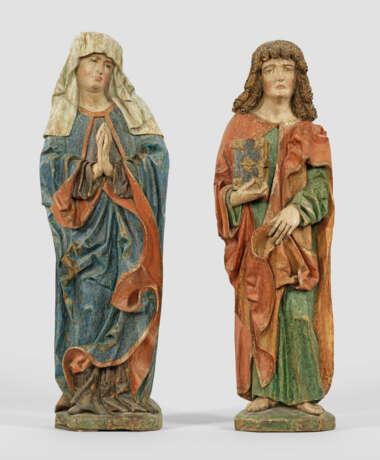ID 1341927
Lot 2756 | Schwäbischer Meister
Estimate value
€ 24 000 – 48 000
(Tätig um 1480-1500 wohl in Ulm)
Maria und Johannes aus einer Kreuzigungsgruppe
Zwei Skulpturen als Gegenstücke. Lindenholz, geschnitzt, rücks. abgeflacht, partiell alte bzw. originale Fassung und Vergoldung. Auf eckigen Plinthen im prononcierten Kontrapost stehende Figuren, ihr rechtes bzw. linkes Spielbein vorangestellt. Die Gottesmutter Maria in bodenlangem, bis auf die Plinthe auslaufendem, blau-rotem, goldumsäumtem Mantel und einem weißen, ihr Gesicht und Hals freilassendem Schleier. Sie wendet sich ihrer linken Seite (ihrem gekreuzigten Sohn Jesus Christus) zu, die Hände in betender Pose vor der Brust gefaltet. Der Lieblingsjünger Jesu, Apostel und Evangelist Johannes ist, der traditionellen Ikonographie entsprechend, als junger Mann dargestellt, in grüner Tunika und einen langen, roten, ebenfalls goldumsäumten Mantel gewandet, der jedoch seine Füße freilässt. In der rechten Hand hält er ein Buch als Attribut vor der Brust, das ihn ausdrücklich als Evangelist kennzeichnet. Sein Kopf fast en face mit schulterlangem, gewelltem Haar, das in Schneckenlocken endet. Von herausragender, künstlerischer Qualität ist insbesondere die Skulptur des Johannes, mit seinem von stillem Ernst und Trauer erfülltem Gesicht. Zu einem weiteren Hauptausdrucksträger werden die Gewänder. In großer Lebendigkeit hat der Bildhauer die weiten, sich volumenhaft aufbauschenden Mäntel mit sehr tiefen, eckig umbrechenden Falten geschnitzt, auch den freien, linken Tunika-Ärmel des Johannes. Während sich der Mantel Mariens in großem Schwung zu ihrem linken Arm hochzieht, ist er bei Johannes zweifach rhythmisiert: er hält mit seiner linken Hand den unteren Saum über seinen Oberschenkel hoch, wodurch die Innenseite sichtbar wird; über seinem linken Oberarm staut sich dann der aufblähende Mantel in Richtung Schulter. Der allgemeine Stil, aber auch der expressive, spätgotische Faltenstil und die Gestaltung der Köpfe lassen auf eine Datierung der Figuren um 1480-1500 schließen und eine Entstehung in Schwaben, vermutlich in Ulm, annehmen. H. 88,5 cm.
South German sculptor active circa 1480-1500 in Swabia, probably in Ulm. A pair of carved and painted limewood sculptures of the Virgin Mary and Saint John the Evangelist from a crucifixion group.
| Auction house category: | Sculptures |
|---|
| Auction house category: | Sculptures |
|---|
| Address of auction |
Kunstauktionshaus Schloss Ahlden GmbH Große Str. 1 29691 Ahlden(Aller) Germany | ||||||||||||||
|---|---|---|---|---|---|---|---|---|---|---|---|---|---|---|---|
| Preview |
| ||||||||||||||
| Phone | +49 5164 80100 | ||||||||||||||
| Buyer Premium | 25.0 | ||||||||||||||
| Conditions of purchase | Conditions of purchase | ||||||||||||||
| Business hours | Business hours
|



